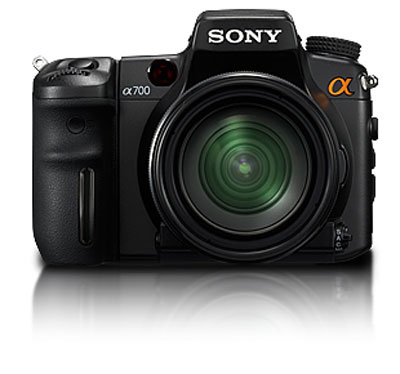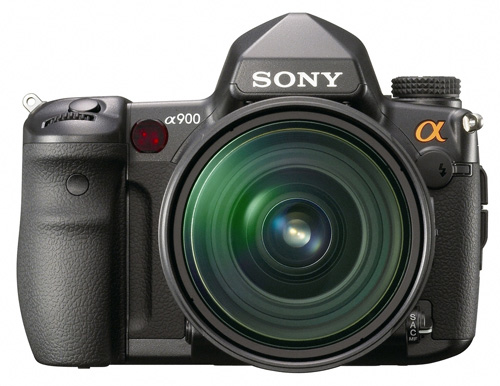Sony A900 Full-Frame: Hands-On Preview
by Wesley Fink on September 12, 2008 12:00 AM EST- Posted in
- Digital Camera
When Sony purchased Konica-Minolta in January of 2006, everyone expected the world's largest digital sensor manufacturer to use the Minolta acquisition to boomerang Sony's entry into the DSLR market. It was soon clear that Sony had ambitious plans for capturing market share in photography's fastest growing market, but the going has been slow.

In the past year Sony has kicked up the pace, beginning with the A700 to compete in prosumer space, followed quickly by the A200 entry-level DSLR, and the A350/A300 DSLRs built with a truly unique and useful Sony implementation of Live View. The Sony Live View is the only Live View that truly behaves like a point and shoot camera in Live View mode. It's as simple as a switch that lets a new user move between Live View and traditional DSLR.
The culmination of the Sony push into the Digital SLR market was unveiled on September 8, after 18 months of hints, speculation, and closed case exhibits at photography events. It is likely that anyone out there who follows photography has at least heard of the A900 - Sony's flagship DSLR and the first to showcase the new Sony 24.6MP full-frame sensor. It also gives the full-frame resolution crown to Sony for the time being, as no other full-frame sensor can claim resolution this high. The closest competitor is the $8000 Canon 1Ds Mark III at 21.1MP.

Sony launched the new A900 in events around the world where invited press and professional photographers were given the opportunity for hands-on time with the A900. It was certainly a controlled environment, with a studio setup with a model and a typical tethered studio shooting product ads. The two environments do reflect how most photographers make their living today, but the manufacturer setups are hardly designed for a competitive comparison. That will have to wait until production cameras arrive in November.
Today we are publishing the A900/Sony DSLR press announcements. You may have already seen the A900 announcement, but we have gathered information on the Sony flagship items together so you can more easily see how the parts contribute to the whole. There was not enough hands-on time to do anything like a thorough analysis of a groundbreaking new camera like the A900. That will have to wait until the release of the A900 in November. However, strong impressions were triggered and we did have enough time with the A900 system to answer many of our questions about the feel, layout, and controls of the new A900. Those impressions are shared on pages seven and eight in our complaints and praise for the new Sony A900.










53 Comments
View All Comments
roweraay - Saturday, September 13, 2008 - link
Obviously, an APS-C 100% viewfinder is only 42% of the size of a Full-frame viewfinder at equivalent magnification. That is a point one has to really keep in mind.Note that the 100% viewfinder at 0.74x magnification, is larger than the viewfinders in the Nikon D3 or the Nikon D700 or the Canon 1DSMKII or the Canon 5D.
In fact, the Sony A900's viewfinder is the 2nd largest Viewfinder EVER, in any DSLR, with the $8000 Canon 1DSMKIII slightly edging it out in size. Note that the precision assembly required and the tighter manufacturing tolerances in a 100% viewfinder, makes it head-and-shoulders above even a 95% viewfinder.
The viewfinder sizes are as below:
Nikon D3: 100% VF with 0.7x magnification
Nikon D700: 95% VF with 0.72X magnification
Canon 5D: 96% VF with 0.71x magnification
Canon 1DSMKII: 100% with 0.7x magnification
Canon 1DSMKIII: 100% VF with 0.76x magnification
Kudos to Sony for getting this in at such a price and specification. Coupled with the fact that only the Sony Full-frame will have stabilized 35mm primes, 50mm primes, 85mm primes, 135mm primes, along with a stabilized 16-35 f/2.8, a stabilized 24-70 f/2.8 etc., makes this a VERY appealing product.
I personally DEFINITELY intend to "vote" for this with my money.
roweraay - Saturday, September 13, 2008 - link
Also note that the Sony Full-RAW files are around 40MB in size, per file, when it comes to the A900.So when shooting RAW at 5FPS, that is around 200MB of image data PER second.
When shooting RAW+JPEG at 5FPS, we need to add another 100MB to the above number, thus taking us to 300MB of data PER SECOND.
What the above means is that the data pipeline architecture needed to support 24.6MP of resolution at 5FPS, is literally equivalent to the data pipeline architecture of MUCH pricier products like the 1DSMKIII and the Nikon D3. This is WAY superior to the architecture in products like the Nikon D700 or the Canon 5D (current version).
Also, dpreview tests show that the A700 is WRITING to the CF-card at around 37MB/Sec, when tested with a 40MB/Sec Sandisk Extreme IV card (max speed: 40MB/Sec). In other words, the A700 is WRITING to the card at almost the full speed of a 266x 40MB/Sec UDMA card. I would assume that with a 300x 45MB/Sec card, it very well might have broken the 40MB/Sec write-to-card speed barrier.
When mentioning the above write-to-card speeds, I need to point out that the above speeds are faster than any other dSLR, regardless of cost. It is faster than the Canon 1DSMKIII, 1DMKIII, Nikon D3, Nikon D300, Nikon D700 etc. Only the Nikon D3/D300 come relatively close to the A700's write-to-CF-card speed.
I would not be surprised if the A900 is even faster, if we employ a 45MB/SEC 300X card to test its write-to-card speed.
I would venture that Sony is employing the full power of its electronics expertise in their high-end pro/semi-pro level cameras.
chiew - Sunday, September 14, 2008 - link
wow...it can beat a three year old camera in write speed. kudos, sony!roweraay - Sunday, September 14, 2008 - link
Maybe you did not read it well enough. ;)The one-year-old Sony A700, is beating every single DSLR *ever* made, regardless of pricepoint, in the write-to-card speed.
The A900 could match it or maybe be even faster !
chiew - Sunday, September 14, 2008 - link
how much does write speed really matter, though?is there any data on 1D mkIII write speeds? because based on more important things, like frames per second, color depth, etc, cameras like the 1d mkIII and nikon d3 have to write pretty damn fast. . i know write speed to card is part of the pipeline, but as long as the camera writes fast enough to keep up with its rated specs, i don't see why write speed is such a huge deal
a700: 5 frames per second, 12 bit, 12 mp
40d: 6.5 fps, 14 bit, 10 mp
1d mkIII: 10 fps, 14 bit, 10 mp
one example of a camera that doesnt keep up is the d300, which when switched into 14 bit mode, cannot keep up with its 6 fps.
Wesley Fink - Saturday, September 13, 2008 - link
A catalog photographer at the Sony presentation has been shooting with the A900 for several weeks. He was a Canon 1Ds Mark III user He also was a user for many years of Hasselblads with Zeiss glass and digital backs. The Zeiss lenses were a big part of his move to Sony.This same photographer quoted the largest capture file size as 68MB, but your 40MB is much closer to the published specs in the A900 brochure. Those charts show a 4GB card can capture 105 full RAW files or 157 cRAW.
I suspect the PRO was referring to the file size of a finished TIFF saved from processing a RAW image since he mentioned he used Capture One for most of his PP. Frankly I didn't know Capture One supported the A700 until he assured us he had used it for his PP with the A700. Capture One will also apparently support the A900 by the time it is shipping. Since the program is widely used by Pros that will be important to many.
roweraay - Sunday, September 14, 2008 - link
The biggest draw for me are the Zeiss AF lenses in the Sony range, too. Specifically the CZ 85mm f/1.4 Planar, the CZ 135mm f/1.8 Sonnar, the CZ 24-70 f/2.8 SSM Vario-Sonnar and the 16-35 f/2.8 SSM Vario-Sonnar. I already have the 85mm and the 24-70 f/2.8 with me and will add the 135 (shortly) and the 16-35 f/2.8 when it becomes available.There were some rumors that there is also an upcoming Carl Zeiss 70-200 f/2.8 SSM Vario-Sonnar, which if true, would provide f/2.8 from 16mm to 200mm. This lens is rumored to replace the current 70-200 f/2.8G SSM (from the Konica-Minolta era).
Wesley Fink - Saturday, September 13, 2008 - link
D3 and not D4. I wish I really had a D4 but it was just a slip of the finger.Rashkae - Saturday, September 13, 2008 - link
Sony does not target this at Pros. It's officially semi-pro, and they said "it's a camera that even pros might want to use".And have you held it? Used it? I have. It's build is so seriously solid it impressed a die-hard D3 user. Don't dismiss the ruggedness of this body, when even the lower-spec A700 survived in conditions the Canon 1Ds-MkIII died in.
melgross - Wednesday, September 17, 2008 - link
They are calling it a pro body here. That's what I'm talking about.And thats pure BS about the A700 vs the 1Ds. I've used the 1Ds and you could use it as a hammer to smash the A700 to a pancake, then go out to shoot some sports.